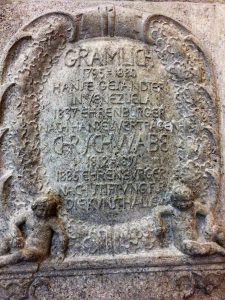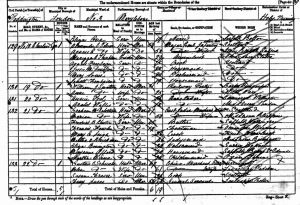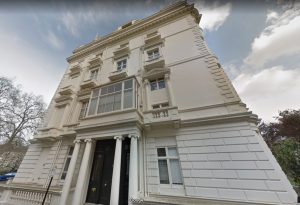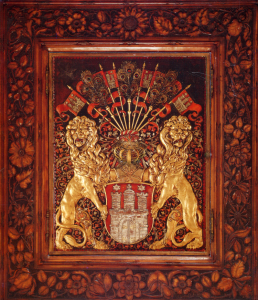Gustav(e) Schwabe was born on 10 October 1813 in Hamburg, Germany. When his father Philipp Benjamin left the Jewish community and joined the Lutheran church in 1819 Gustav was christened Gustav Christian.
On 12 May 1842 he married Helen Dugdale at the parish church of Eccles in Lancashire, the daughter of John Dugdale of Liverpool (<— 3 page pdf on the Dugdale family of Wroxall Abbey showing GCS on page 2) and the sister of John Dugdale of Dovecot House and Llwn Estate, Wales.
Gustav died on 10 January 1897 at his home No. 19 Kensington Palace Gardens, London and he was buried at Henley on Thames on 18 January. His wife Helen died at Kensington Palace Gardens on 26 October 1898. They had no children.
Below the marriage of Gustave and Helen (Dugdale) Schwabe:
In about 1830 Schwabe joined Edward Boustead in Singapore and formed various partnerships which included 1842 Adam Sykes and Benjamin Rutter. Adam was the brother of Elizabeth Sykes who married Stephan Schwabe. For a very brief summary of the Sykes Schwabe Company and the connection to Thomas Hanbury click here.
An article appeared in the Art Journal of 1886 summarizing Gustav’s collection and can be downloaded here in PDF. A page from British History Online mentions GCS’s house (No 19 Kensington Palace Gardens) and can be viewed here (<— external link). A list of the paintings Schwabe donated to the Hamburg Kunsthalle can be found here. After he retired from Singapore he built himself a magnificent house Broughton Hall .
Later on he moved to Kensington Palace Gardens where he began collecting contemporary art, eventually leaving his collection of pictures to his native city; for which bequest he was made an honorary citizen in 1886. This was the first time Hamburg had made the honor since Otto von Bismarck and General Helmut von Moltke in 1871. Schwabe was followed by Johannes Brahms in 1889, by General von Waldersee (who commanded the German troops sent to put down the Boxer Rebellion) in 1901, and by General von Hindenburg in 1917. Below, Schwabe is honored in a hallway of the Hamburg History Museum.

Pictured below is Yewden Manor painted by a member of the circle of artists that Schwabe surrounded himself with. “In 1871 Yewden Manor had been rented from W. H. Smith by an interesting character named Gustav Schwabe, who continued to live there until his death in 1897. He was born in Hamburg in 1813 and was a prominent patron of the arts in his day, He gathered about him at Yewden a number of artists known as the “St. John’s Wood Clique”, many of them Royal Academicians. They included G. D. Leslie, P. H. Calderon, W. F. Calderon, C. B. Stoney, J. E. Hodgson, H. T. Wells and W. F. Yeames. Schwabe, although only a tenant, not only added the south wing and a portion of the centre (indicated by the lower line of the roof) to the Manor House, but also built a number of flint and brick cottages in the village.
In the book ‘Art and Anecdote: Recollections of William Frederick Yeames, R.A. His life and his friends’ by Yeames’s niece, M. H. Stephen Smith, some insight into the life and character of Gustav Schwabe is given and below are some extracts from that work.
“In 1876 came a delightful picture named “The Last Bit of Scandal.” We see a rosy dawn breaking over an old Georgian street of cobbled stones flanked by red bricked walls. Two elegant sedan chairs have stopped and from their raised roofs a poudre lady and gentleman are eagerly recounting to each other the latest tit-bit of gossip.
It was purchased by Mr. Schwabe, a great picture lover. For some years it was hung in his house (more a picture gallery than a house) in [No. 19 Kensington] Palace Gardens, but was eventually transferred with the rest of his collection as a gift to Hamburg, the town of his birth. About which more anon.
Mr. Schwabe was an old friend of my uncle’s, and although a native of Hamburg, he lived entirely in England. He married an English lady [Helen Dugdale (pictured right)] and used the money he made both well and kindly in the land of his adoption. Many a struggling artist and musician (for he was passionately fond of music as well as painting, and was an excellent judge of both) has had cause to bless his name.
He used to send me toffee, special Everton toffee, ordered expressly from Everton itself. The parcel would be wrapped in brown paper and carried with immense dignity by a magnificent footman from the carriage into comb Lodge.
Little acts of kindness; but typical of the giver, for if it was toffee for me, it was probably other things for other people. Outside the matter of toffee Mrs. Schwabe endeared herself to me (such is romantic girlhood) by telling me how she first met her husband. I do not know whether it was the romance of the whole thing, which included a real old-fashioned coach, or because Mrs. Schwabe was so tall and dignified, and Mr. Schwabe so small and thin, with his big nose and black skull-cap, but the story I treasured was that when Mrs. Schwabe, or rather Miss Dugdale, was young, she happened to be taking a journey in a coach which was very crowded and uncomfortable. Seated next to her was a strange young man. Of course, neither spoke to the other. It must have been a long journey, for by night she became so tired that she fell asleep, and only awoke next morning, much refreshed, to find her head pillowed on the shoulder of the strange young man beside her, who had remained motionless the whole night through so as to enable her to repose in comfort.
His kindness impressed her so much that a friendship was begun which ended in matrimony.
Mr. Schwabe was a very shrewd man, one of the originators, I believe, of the White Star Line and the founder of the great shipbuilding works of Harland and Wolff. He used to tell my uncle he had made a combination of brains and money when he formed that partnership.
His great hobby was pictures, and he at last collected so many that he told me he really had to stop buying them because he had had to put the last one under a bed, as there was not a spare bit of wall left in the house! His taste was excellent, and he never bought what was in fashion, but what he saw was really good, and therefore appealed to him personally ; for he lived with his pictures, and positively loved them. When his collection went to Hamburg, he had engravings of them hung in their places.

[A Later Chapter …]
About this time my uncle’s old friend, Mr. Schwabe, beginning to feel the years grow heavy upon him, decided to present his valuable collection of English Masters to his native town of Hamburg. Passionately fond as he was of his paintings, he generously determined to make it a gift, not a legacy with attendant death duties. So he contented himself with engravings of his favourites in place of the originals, and asked his two friends, Mr. Calderon and my uncle, to go over to Hamburg to superintend the hanging of his treasures.
They gladly consented, but to their disgust, on arriving at Hamburg, they found that instead of the pictures going to the fine gallery that Mr. Schwabe had himself given to the town, two wretched rooms at the end of the municipal galleries had been allotted to them.
Knowing what a magnificent gift Mr. Schwabe was presenting, and the extreme generosity and self-denial entailed in the giving, the two friends were furious at this treatment and refused to begin the work of hanging. A deadlock ensued, whilst they placed the matter before Mr. Schwabe.
The old gentleman was terribly upset to think his gift should be received in such a cavalier spirit, but he wired back the three words: “Proceed with work.”
The two friends were almost too annoyed to do so at first, but eventually they decided this would still further upset the kind old man. So they started grudgingly upon their work, doing the best they could with the wretched accommodation accorded them, but having, to their grief, to sky gems and hide masterpieces in corners. [Left Gustav with his wife Helen painted by Philip H. Calderon R.A.]
But before they had quite finished, sightseers from the other rooms began to trickle in, and the news quickly spread that a wonderful collection of pictures had found its way to the town. And then the authorities began suddenly to realize that no one was looking at their original collection. The gift horse’s mouth was then examined, and the municipality awoke to the fact that they had become possessed of what was at that time one of the finest collections of modern English Masters. Then the tide turned, and things began to readjust themselves chiefly in the gastronomic direction, for my uncle said that the banquets given them by the Burghers of Hamburg to show their appreciation were the most wonderful he had ever experienced. They were hours in length, marvels of gastronomy, and most thoroughly appreciated by the givers themselves, who would spend these hours (literally) in sheer joyous concentration and absorption (in more ways than one). In the end, the two honoured guests confided to each other that they would almost be thankful to return to the cold mutton of domesticity.
To Mr. Schwabe himself the Hamburgians presented the Freedom of the City, an honour, I believe, he shared with Bismarck alone. He showed me the document soon after it arrived. It was enshrined behind gilt doors in a gorgeous frame, which opened to reveal an exquisite little painting by Meissonier, behind which again was the precious parchment of the “Freedom.”
—————————————————————–
Another recollection of Schwabe from OUR RIVER BY GEORGE D. LESLIE, R.A.
In the spring of the year 1878 I renewed my acquaintance with the river by spending a week at my friend Mr. Schwabe’s house, called Yewden, at Hambledon. Here also were Messrs. Calderon, Wells, Storey, Hodgson, and Yeames, and as we had all just got rid of our works for the Academy, our spirits were high.
Mr. Schwabe’s house is a very old one, with some modern additions to it of his own. These were executed in great taste, as it is almost impossible to distinguish which of the gables are old and which new.
The house takes its name from the very remarkable old clipped yew avenue, with a sort of nave and transept in it. The garden, lawns, and flower-beds are most admirably managed. Instead of the ordinary stripes of red, yellow, grey, and beet-root colour, with which the thick-headed Scotch gardener usually decorates the flower borders of the wealthy, here, at Mr. Schwabe’s own direction, patchwork and ribbon borders are unknown, and two large sloping banks are planted in glorious profusion and irregularity with every sort of English flower. Pansies of every shade, masses of wallflowers, peonies, polyanthuses, poppies, campanulas, lilies, and a host of others, all growing and blowing in the greatest beauty, and filling the air with delicious perfume.
The little Hamble brook flows through the lawn in front of the house, reminding me a good deal of the one at Ewelme. It is not, however, quite as large as the Ewelme one, and has a nasty trick of running dry in some years.
I had some punting in Mr. Schwabe’s punt, amusing myself by trying my skills in the eddies below the weir; and as there was a good stream on, found it most invigorating work. The river is not, however, very inviting in the early spring, especially when a backward one, as this was; the weeds and flowers have scarcely begun to show at all.
Mr. Schwabe is very fond of sailing boats, and has quite a little fleet of cutters moored off his boat-house; the reach from Hambledon to Henley is very well adapted for sailing, and in the summer time he gets up a sailing regatta here, which is a very pretty sight, especially when the wind blows fresh.
The reach from the weir up to Hedsor Lock is generally allowed to be the most beautiful of any on the river; it certainly is a very stately and noble bit of scenery. There are three eyots, which divide the river in the middle of the reach into four streams, the most charming and romantic of which is the one on the Cliveden side. Mr. Calderon made his studies for his picture of the lovers in a boat, entitled Sighing his Soul into his Lady’s Face, from the banks of the Cliveden woods; this picture has found its way back to the river again, for it now belongs to Mr. Schwabe, and hangs in his house at Hambledon.
_____________________________________________________
Philip Hermogenes Calderon (1833-98) By G. A. Storey, A. R. A.
Among Calderon’s sincere friends and admirers was Mr. Schwabe, who formed a collection of English pictures which he presented to his native town of Hamburg. Among them were several of Calderon’s best works, such as Sighing his Soul into his Lady’s Face (here reproduced), the sweet little head called Constance, and a portrait of a handsome Irish girl holding a basket of roses, which he called La Gloire de Dijon.
CENSUS DATA
1851
1871 Gustav and wife Helen at Broughton Hall near Liverpool:
1881 Gustav and Helen are at 22 Cleveland Square: page 1 (bottom of the page)

page 2 (servants at No. 22 Cleveland Square)

Below, Schwabe’s burial at St. Mary the Virgin, Henley-on-Thames, on January 15th, 1897.
Below Schwabe’s death notice in The Liverpool-Courier of 13 January 1897
Mention of Gustav’s will in The Morning Post 6 April 1897:
Below, Helen’s probate record:














